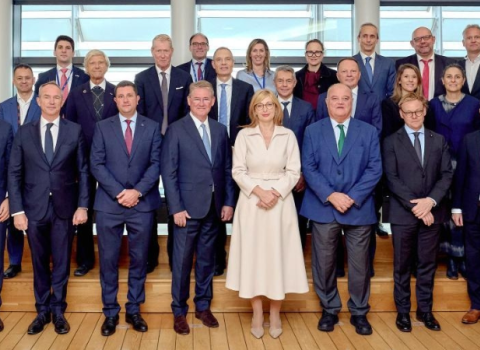Big science is about advancing the frontiers of knowledge. But it is also the source of extraordinary innovation, with huge commercial value and societal impact. So how can Europe become more systematic in extracting this value?
Pinning down the Higgs boson was a stunning intellectual success for CERN, but in many ways the most significant breakthrough to come out of the particle physics laboratory has been Tim Berners-Lee’s idea for the World Wide Web.
And while the World Wide Web may be the best known and most significant innovation to have emerged from one of Europe’s big science projects, it is far from being alone. Technologies inspired by big science include touch screens, scratch resistant glass, Wi-Fi and cochlear implants. These are all driving markets worth billions of euros. However, the EU still needs to overcome a series of obstacles that are slowing down the transfer of technology from big research infrastructures to the market.
Patricia Reilly, member of cabinet of Commissioner Tibor Navracsics, says Europe needs to work on its ability to mine all the good ideas that arise from EU big science funding. “I am convinced that there are plenty of scientific ideas out there that we haven’t figured out how to harness, and that is something we should be able to do,” Reilly says.
Science|Business brought together research, business and policy experts to discuss what the EU can do to boost the economic impact of big science and research infrastructures. The conference featured the publication of Big Science: What’s It Worth?, a Science|Business report on the economic and social value of EU investments in research and innovation.
Success stories
Big science projects produce many positive economic spill overs. The London-based Centre for Economics and Business Research estimated that in Europe, physics-based industries account for €3.8 trillion in turnover, employ 15.4 million directly and, for every one of those, 2.73 jobs elsewhere in the economy. Similarly, the most recent estimate shows that for every dollar the US government invested in the Human Genome project, $141 has been generated in the economy as a result.
There are plenty of other examples that reinforce the economic importance of investing in big science.
At CERN, scientists needed to develop a number of technologies to make the Large Hadron Collider work, and these are now in use in a swathe of applications. These include the porous alloys needed for creating tight vacuums and super conducting wire that is now used in high-power magnetic resonance imaging machines.
CERN detector technology has been applied by Philips Healthcare to improve its medical imaging devices. “We are now closely following the progress of a CERN collaboration project which aims to develop hybrid pixel detectors. This technology could enable spectral x-ray imaging for our medical applications,” said Jan van den Biesen, Vice President for Public R&D Programmes at Philips Research. Spectral x-ray imaging would allow the transition from black & white to colour x-ray imaging, making tissue differentiation possible.
CERN’s detector technology has led to further technological developments by Philips that in turn, CERN could use in its future projects.
Cornelis Eldering, deputy head of technology transfer office at the European Space Agency (ESA), echoed this view and approach. “Science drives technology to its extreme and these technologies then become interesting to apply in other fields than science.”
However, it can take time: technology behind Rosetta and its robotic space probe, built and launched by the ESA in 2004, is now translating through to the market. “It is after almost 20 years of investment that we were able to pick up the fruits,” said Eldering.
Micro arrays developed for Rosetta allowed the production of micro needles needed for efficient vaccinations. Also, the electronic sensors used to analyse the outgassing of the 67P/Churyumov-Gerasimenko comet are now used for detecting bed bugs in hotel rooms.
As another example, Alexander Nietzold, CEO and co-founder of TIND Technologies, developed a professional data management service in the cloud based on CERN’s Document Server. The platform is open source, but TIND provides support and services. “We open source the platform but it is very difficult to install and use, and that’s when we started a professional company that will provide these services,” said Nietzold.
In order to achieve their goals, big science projects need to develop technologies - to make their equipment work, to analyse their data, to get the probe to the comet. It’s these supporting technologies, the nuts and bolts and tools with which big science infrastructure is built and operates, that have the highest economic potential. “It’s all about the screwdrivers,” said Sergio Bertolucci, Director for Research & Scientific Computing at CERN.
For Nietzold, more resources need to be allocated for spinning companies out of big research projects. Otherwise, the ‘screwdrivers’ will be left to gather dust in labs across Europe.
Biology as big science
Traditionally, biology has not been viewed as big science. But with the advent of gene sequencing and the digitisation of biology, it is increasingly becoming so, noted Maria Leptin, director of EMBO.
She pointed in particular to the development of advanced and precise gene editing through the CRISPR/Cas9 technology. “This is a multi-billion dollar industry waiting to happen,” Leptin said.
Genome technologies are generating massive amounts of data, which cannot be shared and put to productive use without fantastic data sharing capacities, Leptin said. “The amount of data increases exponentially every day, but the question is, who curates this data and who guarantees its validity,” she said.
Leptin is also concerned that while individual countries may have the tools to cope with the ethical questions this kind of research is raising, Europe as a whole is lagging behind. “It is amazing that Europe doesn’t have a common set of rules for responsible conduct in science,” she said. In particular, it is very important to get the ethical dimension of big data right. There are too many differences between national and EU level regulations in this area, which need to be addressed. “Scientists are willing to help coordinate national- with European-level policies,” said Leptin.
Robust data infrastructure
Europe also needs to quickly find a solution for the physical management, storage and curation of the data it is currently producing, said Bertolucci. CERN, with its Large Hadron Collider (LHC), has generated one of the biggest datasets in the world. ATLAS alone (one of the LHC experiments) has a dataset of around 150 petabytes. But, in general, Europe doesn’t have a common vision for the big data deluge.
“Unless we develop a consistent strategy on how to store, interpret and use big data, we will not be able to extract the enormous economic potential from it,” said Bertolucci.
The road to commercialisation
In addition to the question of how Europe is to profit from investments in big science projects without a common set of rules for conducting science and without the proper infrastructure needed to share research results, big science faces the dilemma of what it is for. Are we doing science for the sake of knowledge, or do we want to profit from it as well?
For Jonathan Wareham, Dean of Faculty & Research at ESADE Business & Law School, Europe needs to transition from science institutions where the dominant logic is doing science for the sake of science as a social good, to institutions where the dominant logic comes from a business and economic standpoint. “How do you make that transition?” he asked.
Governance systems are needed that allow profit and social good to be reconciled. “We romanticise the discovery and creativity process and then our exercise stops there. This is unfortunate because that’s a very naïve conception of what real entrepreneurship is,” said Wareham.
More emphasis is put on discovery itself than on trying to find a balance between the actual science and its economic value. This part of the cycle is about finding customers, dealing with contracts, dealing with IP and distribution channels – all of which need comparable attention.
In recognition of the need to drive big science through to the market, CERN, the European Southern Observatory, the European Synchrotron Radiation Facility and the European Molecular Biology Laboratory, are putting together ATTRACT, a collaboration aimed at pushing technologies they use in research into the commercialisation cycle.
“Initiatives like ATTRACT provide the processes, the governance and the tools and platforms to make this important transition from idea, to discovery, to commercialisation,” Wareham said.
Planning for the future: how to boost the economic return of big science?
Antonio Di Giulio, head of the Research Infrastructures unit at DG RTD, European Commission, said the Commission is looking for ways to couple excellence and the social and economic impact of big science. “We are thinking how the Commission can reduce risks on investments in research infrastructures and make sure the industry goes into disruptive mode,” said Di Giulio.
For big science projects to have an economic impact and for innovation to actually work, Europe needs more regulatory certainty, believes Patricia Reilly. Funding alone is not sufficient. Researchers, companies and investors need to know that, “the playing field will stay the same in the next 10-20 years,” she said.
Shiva Dustdar, head of RDI Advisory at the European Investment Bank (EIB) said the bank can play a catalytic role in financing open science. “The EIB can help create a bridge between big funding, support from the member states, and private capital. We can find ways to ascribe value and monetise and capture the economic value of research,” said Dustdar.
The role of the public sector needs to be rethought, from a system which very often socialises the losses, to a system that also socialises the gains. “There must be a way to capture that because that is the only way to bring private capital to the game,” Dustdar said.





 A unique international forum for public research organisations and companies to connect their external engagement with strategic interests around their R&D system.
A unique international forum for public research organisations and companies to connect their external engagement with strategic interests around their R&D system.